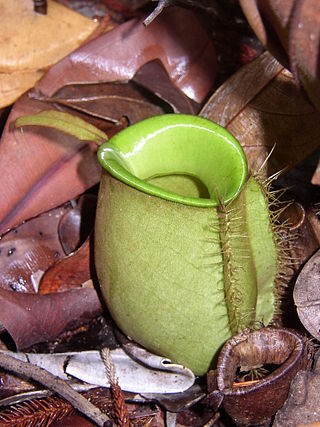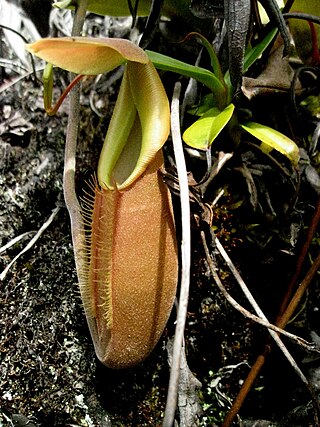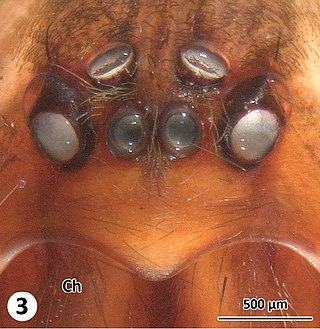
Crevice weaver spiders (Filistatidae) comprise cribellate spiders with features that have been regarded as "primitive" for araneomorph spiders. They are weavers of funnel or tube webs. The family contains 18 genera and more than 120 described species worldwide.

Titanoecidae is a family of araneomorph spiders first described by Pekka T. Lehtinen in 1967. It is fairly widespread in the New World and Eurasia with five genera and more than 50 species worldwide. These are mostly dark-colored builders of "woolly" (cribellate) silk webs. Several species are found at relatively high altitudes in mountain ranges and may be very common in such habitats.

Nepenthes ampullaria is a very distinctive and widespread species of tropical pitcher plant, present in Borneo, the Maluku Islands, New Guinea, Peninsular Malaysia, Singapore, Sumatra, and Thailand.

Nepenthes reinwardtiana is a tropical pitcher plant native to Borneo and Sumatra and to a number of smaller surrounding islands including Bangka, Natuna, Nias, and Siberut. Although some sources have included Peninsular Malaysia and Singapore within the range of this species, these records appear to be erroneous.

Nepenthes stenophylla, or the narrow-leaved pitcher-plant, is a tropical pitcher plant endemic to Borneo. The species produces attractive funnel-shaped pitchers up to 25 cm high. It is listed as Least Concern on the IUCN Red List. Nepenthes stenophylla belongs to the loosely defined "N. maxima complex", which also includes, among other species, N. boschiana, N. chaniana, N. epiphytica, N. eymae, N. faizaliana, N. fusca, N. klossii, N. maxima, N. platychila, and N. vogelii.

Nepenthesinfauna are the organisms that inhabit the pitchers of Nepenthes plants. These include fly and midge larvae, spiders, mites, ants, and even a species of crab, Geosesarma malayanum. The most common and conspicuous predators found in pitchers are mosquito larvae, which consume large numbers of other larvae during their development. Many of these animals are so specialised that they cannot survive anywhere else, and are referred to as nepenthebionts.

Nepenthes bongso is a tropical pitcher plant endemic to Sumatra, where it has an altitudinal distribution of 1000–2700 m above sea level. The specific epithet bongso refers to the Indonesian legend of Putri Bungsu, the spirit guardian of Mount Marapi.

Austrochilidae is a small spider family with nine species in two genera. Austrochilus and Thaida are endemic to the Andean forest of central and southern Chile and adjacent Argentina.
Microhyla borneensis, also known as the Matang narrow-mouthed frog, is a species of microhylid frog found in the Matang Range in Sarawak, Borneo. It was once the smallest known frog from the Old World. Adult males of this species have a snout-vent length (SVL) of 10.6–12.8 mm (0.42–0.50 in), but adult males can reach a maximum of 13 mm (0.51 in),and adult females of this species have a snout-vent length of 16–19 mm (0.63–0.75 in), Tadpoles measure just 3 mm.
Zorodictyna inhonesta is a species of spider in the family Udubidae, found in Madagascar. It was first described by Eugène Simon in 1906 as Uduba inhonesta. Pekka T. Lehtinen transferred it to the genus Zorodictyna in 1967, although Pierre L.G. Benoit was still using the name Uduba inhonesta in 1972.
Zorodictyna oswaldi is a species of spider in the family Udubidae, found in Madagascar. It was first described in 1891 by Heinrich Lenz as Agroeca oswaldi. The species name honours Albert O'Swald whose collection had been given to Lenz; the name was originally written o'swaldi. In 1908 Embrik Strand placed it in the genus Uliodon; in 1967 Pekka T. Lehtinen transferred it to Zorodictyna.
Andoharano is a genus of African crevice weavers that was first described by Pekka T. Lehtinen in 1967.
Baiami is a genus of Australian intertidal spiders that was first described by Pekka T. Lehtinen in 1967. Originally placed with the Stiphidiidae, it was transferred to the Desidae after the results of a 2019 genetic analysis.
Lamania is a genus of Southeast Asian araneomorph spiders in the family Pacullidae that was first described by Pekka T. Lehtinen in 1981. Originally placed with the armored spiders, it was moved to the Pacullidae in 2017.
Ansiea is a genus of crab spiders that was first described by Pekka T. Lehtinen in 2004. This genus was named in honour of South African arachnologist Ansie Dippenaar-Schoeman. As of June 2020 it contains two species found in Africa and Saudi Arabia: A. buettikeri and A. tuckeri.
Henriksenia is a genus of crab spiders that was first described by Pekka T. Lehtinen in 2004.

Megadictynidae is a family of araneomorph spiders first described by Pekka T. Lehtinen in 1967. They are endemic to New Zealand.
Misumenops nepenthicola can refer to two species of spider:
Henriksenia labuanica is a species of spider in the family Thomisidae, found in Malaysia (Borneo).

Misumenini is a tribe of spiders in the family Thomisidae.









